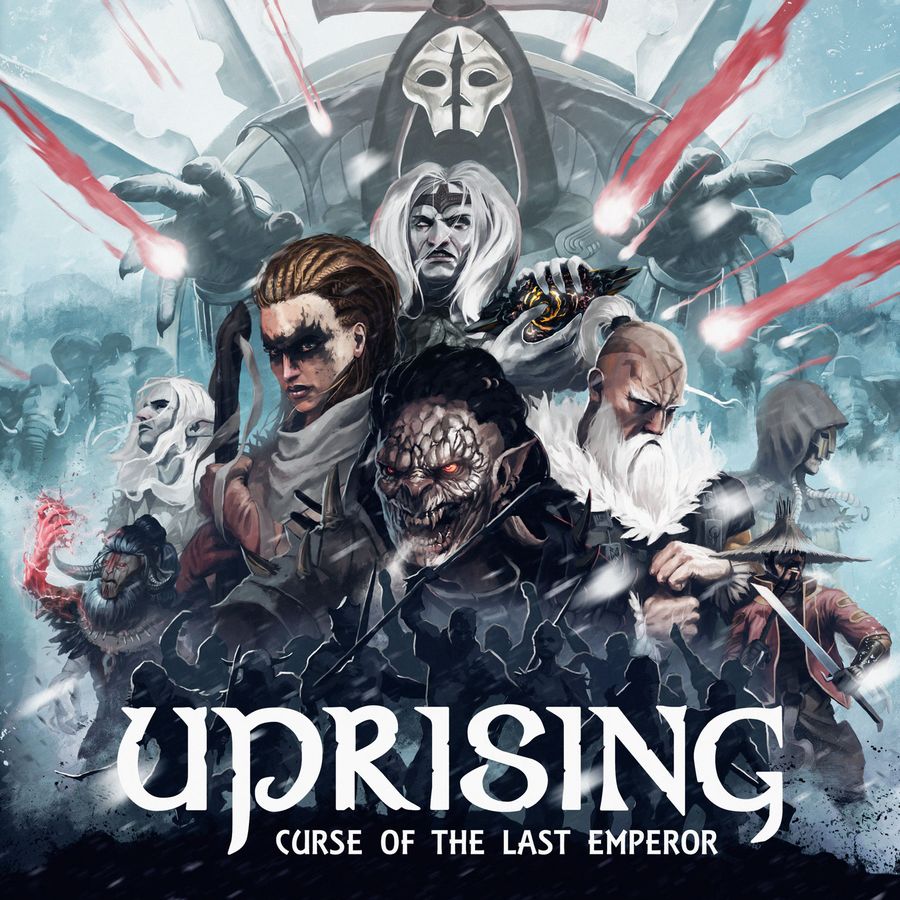Kickstart This! #268: Uprising: Curse of the Last Emperor

Designers: Cornelius Cremin, Pawel Mazur, Dirk Sommer
Artists: Igor Desic, Bartek Fedyczak (Age of Thieves, Flotilla, Vindication), Dirk Sommer
Publisher: Nemesis.Games
Genre/Mechanisms: 4x, action points, area majority/influence, civilization, cooperative game, dice rolling, economic, modular board, variable player powers, wargame
Funding Status: At the time of this posting Uprising: Curse of the Last Emperor is already fully-funded. Pledges currently total more than 7x the initial funding goal with less than 2 days to go on the campaign.
Player Count: 1-4
Solo Mode: yes
Complexity: heavy
Risk: HIGH
What It’s About: “A 4X cooperative game played against two asymmetric enemy factions controlled by the game itself: Chaos and the Empire. Explore the wasteland, expand your dominion, exploit the resources of the liberated territories, and exterminate the Legions and Hordes around you.”
How It Works: “A game of Uprising can last from two to four game turns, called Chapters. Each Chapter is divided into seven Phases in which you will resolve unique Events, upgrade your Hero and Faction, build armies and fight epic battles. Use the Chapter Track on the side of the Map to keep track of where you are in the Chapter.” The seven Phases of the game are the Refresh Phase, Events Phase, Build Phase, Actions Phase, Nemesis Phase, Production Phase, and Scoring Phase.
During the Refresh Phase, players reveal a Druid (adding specific combat abilities for the Chapter), flip their face-down cards back to face-up, remove spent Action Points, deal 3 new Items and 3 new Quests, and pass the First Player Token to the left.
During the Events Phase, players “populate the map with Imperial Legions and Chaos Hordes as well as other effects shown on the Event Card revealed each Chapter.”
During the Build Phase, players each simultaneously “draw 2 Feats from their Feat Deck, then pick 1. The Feat is immediately active, so players can use it after they play it. They discard the other Feat by putting it at the bottom of the Feat Deck.” Then they may “place any Units, Walls or Towers they pay for on any of their Havens. Pay the Resources listed for each Unit or Defense listed on their Player Board. And remember the Hex Limits of 5 Player Units, 1 Haven, 1 Tower, and 1 Wall.”
During the Actions Phase, players take turns in clockwise order spending their Action Points to take Actions. Actions include Move (Hero movement), Trade, Command (the Hero commanding other units to move), Explore (taking the action of the associated Hex tile), Haven, Market, and Quest.
During the Nemesis Phase, the A.I. Empire and and Hordes of Chaos factions activate.
During the Production Phase, players gain resources based on Havens.
And finally during the Scoring Phase, the Empire, Chaos, and player factions score points. Player factions score 2 VP per Haven and sometimes VP for certain resources. Players may also trade 5 resources for 1 VP as many times as they so choose. This is typically done most at the end of the ground when players no longer require resources.
“At the end of the last Chapter, the game is over. If all the players each individually have more VP than The Empire and Chaos (at the end of the last Chapter), congratulations. You have collectively built the strongest possible bulwark against the encroaching Chaos, and defeated the relic of the Empire. Your allied people will be able to forge new nations in the ruins of Azuhl. At the end of the last Chapter, if The Empire has equal or more points than a Player, your people face enslavement again as they are outranked and ground down by their military machine. At the end of the last Chapter, if Chaos has equal or more, you have suffered a fate worse than death. Either way, there is little hope left for life in Azuhl- the free factions have faltered before the tide.”
Comparisons: The variable mechanics and scoring opportunities, as well as the ability for players to complete quests, calls to mind games like Lords of Hellas and Vindication. And Martin Wallace’s AuZtralia features players battling an A.I. faction while also competing against one another, though it certainly would not be considered a cooperative game. Vital Lacerda’s CO2: Second Chance includes a cooperative mode, and even the competitive mode requires players to work together until the last round or two to prevent the construction of fossil fuel plants (which acts as an A.I. mechanic), or the world ends and all players lose the game. But examples of 4x games that are also cooperative are virtually non-existent. However, a few standouts in the 4x genre include Dominant Species, Eclipse, Empires of the Void II, and Twilight Imperium. And a few cooperative games with some similarities to the 4x genre includes Mage Knight, Nemesis, and Spirit Island.
What Should I Pledge?:
$79 Core Pledge: includes the Uprising Core Box with 4 factions (Fallen Invaders, Forgotten Guardians, Nebulous Wanderers, and Unbending Highlanders), their 8 Heroes, and all unlocked stretch goals.
$129 All-In Pledge: includes everything in the Core Pledge plus an additional 4 factions (The Last Herd, Renegade Legion, Shadow Striders, and Wave Singers) and their 8 Heroes, as well as the Arch-Nemesis Expansion.
Add-Ons:
Free Rise of the Old Gods Campaign Journal .PDF
$15 Dice Pack: includes 28 additional dice
$10 Item Pack: includes 20 additional Item Cards
$35 Playmat: must be ordered separately through the Deep Cut Studio website
KS Exclusives
The entire project is a Kickstarter Exclusive, and will not be headed to retail.
All-In Total: In the continental U.S., you’re looking at $129 for the All-In Pledge, $10 for the Item Pack, and $26 in shipping for a total of $165. If you want the Playmat, it must be ordered separately via a third-party website.
Uprising: Curse of the Last Emperor completes its Kickstarter on Thursday, September 10th and tentatively ships in August 2021.